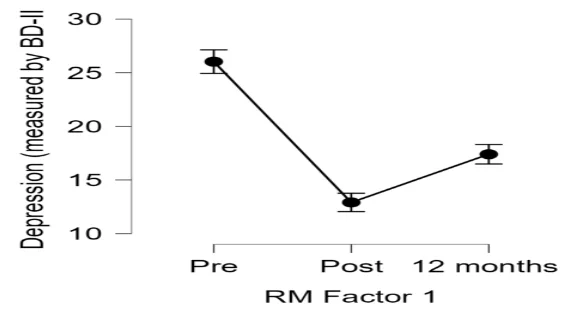1. Paired Sample T-Test: Comparing Pre and Post-Treatment Depression Levels in the EBCT Group
Problem Description:
The statistical analysis assignment aimed to evaluate the effectiveness of Emotion-Focused Brief Couples Therapy (EBCT) in reducing depression levels. Depression was measured using the WHO-5 scale before and after treatment.
Results: A paired sample t-test revealed a significant decrease in depression levels after EBCT. The average WHO-5 score increased from 7.34 (SD=3.86) before treatment to 15.82 (SD=4.01) after treatment (t(99)=-21.38, p<.001, d=-2.14).
Paired Samples T-Test
| Measure 1 | Measure 2 | t | df | p | Mean Difference | SE Difference | Cohen's d | ||||||||||
|---|---|---|---|---|---|---|---|---|---|---|---|---|---|---|---|---|---|
| WellbeingPre | - | WellbeingPost | -21.383 | 99 | < .001 | -8.480 | 0.397 | -2.138 |
Note. Student's t-test.
Descriptives
| N | Mean | SD | SE | ||||||
|---|---|---|---|---|---|---|---|---|---|
| WellbeingPre | 100 | 7.340 | 3.862 | 0.386 | |||||
| WellbeingPost | 100 | 15.820 | 4.006 | 0.401 |
Table 1: Paired samples T-Test
2. Mauchly Test: Testing Sphericity Assumption for BDI-II Levels in EBCT Group
Problem Description:
The study examined the sphericity assumption for depression levels measured by BDI-II at pre-treatment, post-treatment, and 12 months after treatment.
Results: The Mauchly test indicated a violation of sphericity (p=.006), suggesting that the assumption did not hold.
Table 2: Test of Sphericity:
Test of Sphericity
| Mauchly's W | Approx. Χ² | df | p-value | Greenhouse-Geisser ε | Huynh-Feldt ε | Lower Bound ε | |||||||||
|---|---|---|---|---|---|---|---|---|---|---|---|---|---|---|---|
| RM Factor 1 | 0.902 | 10.123 | 2 | 0.006 | 0.911 | 0.927 | 0.500 | ||||||||
3. Figure 2: Error Bar Showing Mean and 95% Confidence Interval of Depression Score (BDI-II) at Different Timepoints

4. Repeated Measure ANOVA: Examining Depression Levels at Different Timepoints for EBCT Group
Problem Description:
The study investigated if there was a significant difference in depression levels (BDI-II) at pre-treatment, post-treatment, and 12 months after treatment.
Results: A repeated measure ANOVA showed a significant difference (F(2,198)=190.54, p<.001, η^2=0.66) in average depression scores at different timepoints.
Within Subjects Effects:
- RM Factor 1: F=190.54, p<.001, η^2=0.66
5. Holm’s Correction for Pairwise Comparisons: EBCT Group Depression Levels at Different Timepoints
Problem Description:
Pairwise comparisons were conducted to examine significant differences in depression levels between pre-treatment, post-treatment, and 12 months after treatment in the EBCT group.
Results: Significant differences were found between:
- Pre- and post-treatment (p<.001)
- Pre- and 12 months after treatment (p<.001)
- Post-treatment and 12 months after treatment (p<.001)
Post Hoc Comparisons:
- Pre vs. Post: Mean Difference=13.120, p<.001
- Pre vs. 12 months: Mean Difference=8.630, p<.001
- Post vs. 12 months: Mean Difference=-4.490, p<.001
6. Independent Sample T-Test: Comparing Post-Treatment Depression Levels in EBCT and CBT Groups
Problem Description:
The study aimed to compare post-treatment depression levels between Emotion-Focused Brief Couples Therapy (EBCT) and Cognitive-Behavioral Therapy (CBT) groups.
Results: An independent sample t-test showed a significant difference
Independent Samples T-Test
| df | p | Mean Difference | SE Difference | Cohen's d | |||||
|---|---|---|---|---|---|---|---|---|---|
| 198 | 0.024 | -1.920 | 0.846 | -0.321 | |||||
Note. Student's t-test.
Group Descriptives
| Group | N | Mean | SD | SE | |||||
|---|---|---|---|---|---|---|---|---|---|
| CBT | 100 | 10.990 | 5.458 | 0.546 | |||||
| EBCT | 100 | 12.910 | 6.467 | 0.647 |
Table 3: Independent sample T-Test
7. Effectiveness of EBCT in Reducing Depression Levels
The results indicate a significant reduction in depression for the EBCT group at post-treatment and 12 months after treatment. However, post-treatment depression levels for EBCT were higher than those for the CBT group, suggesting that EBCT may be less effective than standard CBT therapy. Further research is warranted to explore the comparative effectiveness of different therapeutic approaches.